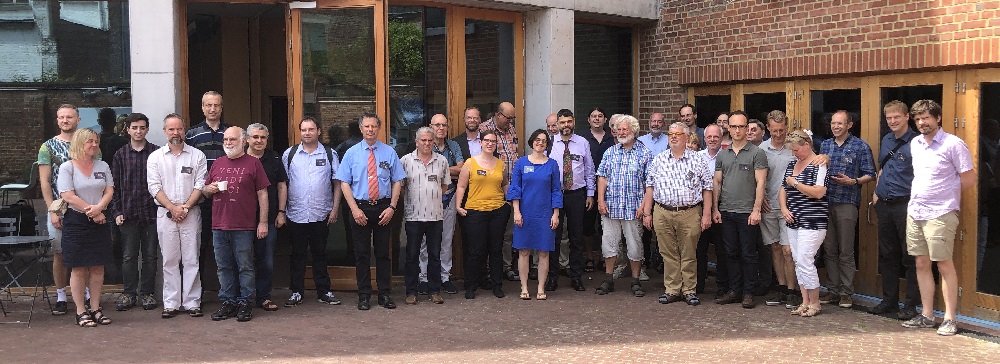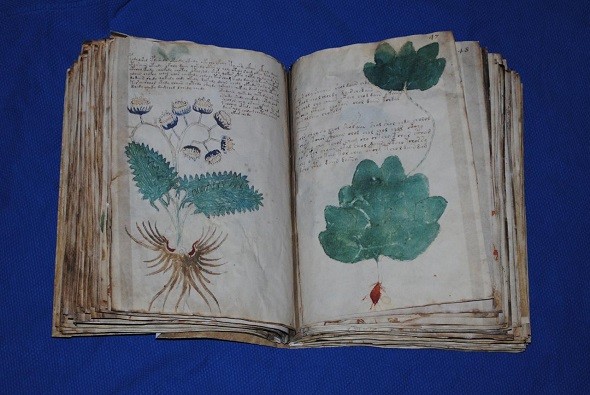René Zandbergen is in my view the world’s leading Voynich manuscript expert. A talk he gave at HistoCrypt 2019 and his website provide interesting pieces of information.
HistoCrypt 2019 in Mons, Belgium, …

Source: Schmeh
… saw many great presentations. One of the best was the talk No News about the Voynich Manuscript by René Zandbergen. I had invited René to HistoCrypt because I know him as one of the leading (or even the leading) Voynich manuscript experts. René’s web-site is, in my view, the best Voynich manuscript source in existence.

Source: Schmeh
René’s HistoCrypt paper
René has summarized his HistoCrypt talk in a paper, which is now available on Academia.edu. If this link doesn’t work (which was the case when I tried it), you can download the paper here.
In his paper, René summarizes the current state of Voynich manuscript research. While the text in this mysterious tome still can’t be read, there has been some progress with respect to the material the manuscript is made of in recent years. As is meanwhile well known, a radiocarbon analysis conducted in 2009 dated the parchment to the early 15th century. A microscopic examiniation showed that the material used (including ink and paint) is consistent with a book created in the late Middle Ages.
In 2014, a few more analyses were made during a Voynich manuscript exhibition in Washington, D.C. These examinations rendered the following results.
- The parchment of the manuscript is made of calfskin.
- The parchment is not of very high quality, but it was very well prepared, to the extent that it is hardly possible to distinguish which ist he flesh side and which the skinside of the parchment.
- The present cover is made of goatskin.
- The present cover is not the original one. An earlier cover of the manuscript had wooden boards covered by tanned leather.
- The stitching/sewing of the binding is very old, perhaps even 15th century.
- The Voynich manuscripts lacks yellow paint, which is very unusual for a herbal manuscript. This apparent lack of yellow paint is caused by the use of organic colorants that have faded over the ages.
- The clothes worn by the figures depicted are typical for the 1420’s and would be unknown even a few decades later.
- Additional forensic tests confirmed that no unusual chemical constituents were found in the inks and paints.
- Multi‐spectral imaging revealed no instance of erased text, beyond the entries already known on the first folio of the manuscript.
In addition, René’s paper addresses the provenance of the Voynich manuscript. Among others, emperor Rudolf II and alchemist Georgius Barschius are believed to have owned the book (both is not proven, however).
What makes deciphering difficult
And then, René addresses the many alleged solutions of the Voynich manuscript text (some of which have been covered on this blog). None of these has ever been accepted by the expert community. As René points out, it is far from clear that the text in the manuscript can be decrypted at all. Instead of “what does it mean?” that question asked should be “how was it done?”.
Every answer to this question needs to explain why the text in the manuscript has some unusual properties. Especially, the structure of the words is much more regular than in any known natural language (most of the words can be assembled from a relatively small set of syllables). Such a phenomenon doesn’t appear when one of the ciphers known in the early days of crypto history is applied on an ordinary text.
What René believes
If you want to know more about what René thinks is behind the Voynich manuscript, I recommend the page My Views on his Voynich website. According to René, there is no simple answer to the many questions about the manuscript. So, he begins his treatise with the following words:
Do I have a Voynich MS solution in mind? The short answer is a definite no. I don’t have any preferred theory, and as it is, I cannot even think of any scenario that would explain everything I know about the Voynich MS.
Here are some of René’s opinions:
- The Voynich MS is from the fifteenth century, not a modern forgery.
- The manuscript is from the Alpine region. The herbals to which it is most similar in style all originate from Northern Italy. The zodiac illustrations in the manuscript fit in a style prevailing in South German manuscripts of the entire 15th century, so it is unclear whether the place of origin is rather North or South of the Alps.
- The Voynich manuscript is probably the work of one “brain”. There are signs that the text has been copied from a draft. There is even a hint that the copyist did not understand what he was copying, which would mean that the copyist was not the same person as the original author.
- The Voynich manuscript does not look like a document commissioned by a client. It rather looks like this was someone’s own initiative. The author was familiar with philosophical (scientific) books of his time.
René likes the hypothesis brought forward by Sergio Toresella that the Voynich manuscripts was made by a quack just in order to appear very learned. He could also imagine that the manuscript is someone’s masterpiece, to be used to enter one of the secret societies that existed at the time.
As I am a crypto specialist, not an art historian, my main question has always been whether the text in the Voynich manuscrippt is plaintext, ciphertext, or meaningless. René sees a fourth possibility, namely that there was an original meaning but it has become irrecoverable through the encoding or inaccurate copying process.
René’s answer: “In general, I just don’t know which is the correct or even most likely answer, so I prefer to keep all options open.”
Follow @KlausSchmeh
Further reading: A test for checking whether a Voynich Manuscript solution is correct
Linkedin: https://www.linkedin.com/groups/13501820
Facebook: https://www.facebook.com/groups/763282653806483/



Kommentare (48)